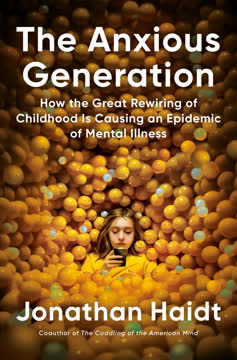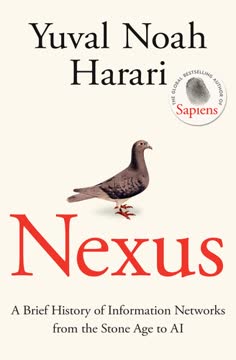Key Takeaways
1. The Content Trap: Focus on connections, not just content
"Connections can help businesses, not just harm them."
Connections are key. The Content Trap is the tendency to focus solely on creating superior content, while overlooking the importance of connections. This mindset can lead businesses astray, especially in the digital age. Successful companies understand that value often lies in the relationships between users, products, and organizational choices.
- Three types of connections:
- User connections (e.g., network effects)
- Product connections (e.g., complements and spillovers)
- Functional connections (e.g., aligned organizational choices)
By recognizing and leveraging these connections, businesses can create sustainable advantages that are difficult for competitors to replicate. The focus shifts from simply producing great content to creating ecosystems that enhance value through interconnectedness.
2. User Connections: Network effects and preference connections drive success
"Network effects are all about user connections."
Understanding user behavior is crucial for success in digital markets. Network effects occur when a product or service becomes more valuable as more people use it. This can create powerful feedback loops that lead to winner-take-all dynamics.
- Examples of network effects:
- Social media platforms
- Messaging apps
- Online marketplaces
Preference connections refer to how users' choices are influenced by others. This can be seen in phenomena like viral content or the adoption of new technologies. Companies that successfully leverage these connections can rapidly scale their user base and create strong barriers to entry for competitors.
3. Product Connections: Complements and spillovers create value
"Expand your vision, not narrow it."
Think beyond core products. Complements are products or services that enhance the value of your core offering. By recognizing and nurturing complementary relationships, companies can create ecosystems that provide more value to customers and capture a larger share of the market.
- Examples of successful complement strategies:
- Apple's App Store ecosystem
- Amazon's Marketplace for third-party sellers
- Concerts and merchandise for musicians
Spillovers occur when the success of one product positively impacts related offerings. This can be seen in the entertainment industry, where a hit TV show or movie can boost sales of related merchandise, books, or theme park attractions. By understanding these connections, businesses can create strategies that maximize value across their entire portfolio.
4. Functional Connections: Align choices across the organization
"Connected decisions preserve and amplify winning strategies."
Organizational alignment is crucial. Functional connections refer to how different decisions and activities within an organization work together to create a cohesive strategy. Successful companies ensure that their choices across various functions (e.g., marketing, product development, operations) are mutually reinforcing.
- Key aspects of functional connections:
- Consistency in decision-making
- Prioritization of initiatives
- Cross-functional collaboration
By recognizing these connections, companies can create strategies that are difficult for competitors to imitate. This is because the advantage comes not from any single decision, but from the unique combination of choices that work together as a system.
5. Digital Strategy: Prioritize and say no to create differentiation
"Being constrained financially is not a bad thing. It allows you to take creative risks without the fear that undermines creativity."
Focus is essential. In the digital age, where possibilities seem endless, the ability to prioritize and say no becomes a crucial competitive advantage. Successful digital strategies often involve making clear choices about what not to do, rather than trying to pursue every opportunity.
- Key principles for effective digital strategy:
- Identify core strengths and focus areas
- Eliminate non-essential initiatives
- Invest heavily in chosen priorities
By concentrating resources on a few key areas, companies can achieve excellence and differentiation in a crowded market. This approach requires discipline and the courage to forgo seemingly attractive opportunities that don't align with the core strategy.
6. Adapt to Context: Tailor strategies to local conditions
"There is little advantage to being global in e-commerce."
Context matters. While digital technologies can enable global reach, successful strategies often require adaptation to local conditions. This is particularly evident in e-commerce and digital media, where user behaviors, infrastructure, and cultural norms can vary significantly across markets.
- Factors to consider when adapting strategies:
- Local user preferences and behaviors
- Infrastructure and technology adoption
- Regulatory environment
- Cultural nuances
Companies that recognize the importance of context can create tailored approaches that resonate with local users, often outperforming global giants who fail to adapt. This principle extends beyond geographic adaptation to include understanding the unique context of different user segments or product categories.
7. Rethinking Advertising: Effectiveness trumps reach and targeting
"Advertising convinced people to need things they don't really need."
Effectiveness is key. The digital age promised revolutionary changes in advertising through precise targeting, better measurement, and interactivity. However, the reality has been more complex. While these capabilities have value, they haven't necessarily translated into dramatically improved advertising effectiveness.
- Challenges in digital advertising:
- Low click-through rates
- Ad blocking and avoidance
- Difficulty in measuring true ROI
Successful advertising strategies focus on creating value for users, rather than simply maximizing reach or targeting precision. This might involve creating content that users actually want to engage with, or finding ways to integrate advertising more seamlessly into user experiences. The most effective approaches recognize that advertising is not just about interrupting users, but about creating meaningful connections between brands and consumers.
</instructions>
Last updated:
FAQ
What is The Content Trap: A Strategist’s Guide to Digital Change by Bharat Anand about?
- Connections over content: The book argues that success in digital media and content industries depends more on managing connections—between users, products, and organizational functions—than on content quality alone.
- Digital transformation focus: Anand explores how digital technologies have disrupted traditional businesses, emphasizing the need to understand the forces and connections shaping digital success.
- Broader relevance: While rooted in media, the book’s frameworks apply to education, advertising, and other sectors, showing how connectivity drives strategy and innovation.
Why should I read The Content Trap by Bharat Anand?
- Avoid common pitfalls: The book helps readers recognize and sidestep the “Content Trap”—the mistake of focusing solely on content and missing the bigger picture of connections.
- Real-world case studies: Anand draws on examples from The New York Times, Tencent, The Economist, and Harvard Business School, offering practical lessons for digital strategy.
- Strategic frameworks: Readers gain actionable frameworks for navigating digital change, prioritizing initiatives, and building sustainable competitive advantage.
What are the key takeaways of The Content Trap by Bharat Anand?
- Connections trump content: Success comes from managing user, product, and functional connections, not just creating great content.
- User-centered mindset: Shifting from a product-centered to a user-centered approach fosters engagement, trust, and viral sharing.
- Digital-first and differentiation: Reimagining offerings for digital platforms and focusing on unique strengths lead to better engagement and scalability.
What is the “Content Trap” as defined by Bharat Anand in The Content Trap?
- Narrow content focus: The Content Trap is the error of obsessing over content quality or isolated product features, ignoring the broader ecosystem of connections.
- Misplaced defensive strategies: It includes efforts to protect existing products at all costs, missing opportunities in complements and related areas.
- Ignoring context and connections: The trap involves searching for universal best practices and failing to recognize the importance of context and internal alignment.
What is the Connections Triad framework in The Content Trap and why is it important?
- Three types of connections: The framework highlights user connections (between users), product connections (among products/services), and functional connections (within organizations).
- Explains digital success: These connections explain why some companies thrive and others fail in digital transformation.
- Strategic alignment: Recognizing and managing these connections helps organizations create value, defend against disruption, and sustain competitive advantage.
How do user connections drive digital business success according to The Content Trap?
- Network effects: The value of a product or service often increases as more users join, as seen in social networks and messaging platforms.
- Competitive advantage: Strong user connections can protect companies from competition and mistakes, as with Microsoft’s operating system dominance.
- Late-mover opportunities: Companies can win even as late entrants by effectively leveraging user connections, as demonstrated by Schibsted.
What are product connections and how do they create value in The Content Trap?
- Complements boost value: Products that complement each other, like concerts and recorded music, can increase overall demand and revenue.
- Spillovers amplify success: Success in one product can spill over to others, such as TV lead-in effects or book sales from related media.
- Portfolio management: Managing a diverse set of connected products, rather than focusing narrowly, helps companies like IMG succeed.
What are functional connections and how do they shape strategy in The Content Trap?
- Organizational alignment: Functional connections are the interdependencies among activities, decisions, and strategies within a company.
- Amplifying effects: Choices in content, marketing, pricing, and operations must be coordinated to reinforce each other and sustain advantage.
- Difficult to imitate: Well-aligned functional connections make a company’s strategy harder for competitors to copy.
How does Bharat Anand in The Content Trap explain the failure of the music industry to respond to digital change?
- Misidentifying threats: The industry focused on fighting piracy and preserving CDs, missing the shift in value to concerts and digital formats.
- Historical parallels: Past disruptions (radio, MTV, VCRs) were seen as threats but became complements that expanded the market.
- Mindset error: The product-oriented mindset led to defensive strategies, illustrating the dangers of the Content Trap.
What lessons does The Content Trap offer about digital transformation and strategy prioritization?
- Start with user behavior: Understanding how customers behave and what they value is essential before making strategic choices.
- Prioritize and say no: Trying to do everything leads to misalignment; successful companies focus on a few key initiatives.
- Align around strategy: Content, marketing, pricing, and culture must be coordinated to reinforce the chosen strategy and leverage connections.
How does The Content Trap analyze the role of advertising and user-centered marketing?
- Brand legacy matters: Advertising’s impact depends on the publisher’s brand; trusted brands must be careful with ad quality.
- Native and integrated ads: Native advertising and integrated campaigns can increase engagement without deceiving users.
- User co-creation: Involving users in product design and marketing leads to more authentic, effective campaigns and deeper loyalty.
What are the best quotes from The Content Trap by Bharat Anand and what do they mean?
- “Expand to Preserve”: Defend your core product by seeking value-creating opportunities beyond it, embracing complements and connections.
- “It’s about the use case, not the device”: Understanding user behavior is more important than focusing on technology itself.
- “Dare to not mimic”: Success comes from recognizing your unique context and connections, not from copying others’ strategies.
Review Summary
The Content Trap is praised as an insightful guide to digital strategy, focusing on the importance of connections rather than content alone. Readers appreciate Anand's analysis of various industries and his emphasis on user, product, and functional connections. The book is lauded for its well-structured arguments, compelling case studies, and practical applications. While some found it challenging to read due to its depth, many consider it essential for those in media, education, and business. Critics note occasional repetitiveness and self-promotion, but overall, the book is highly recommended for its fresh perspective on digital transformation.
Similar Books









Download PDF
Download EPUB
.epub digital book format is ideal for reading ebooks on phones, tablets, and e-readers.




